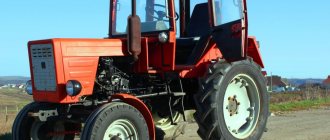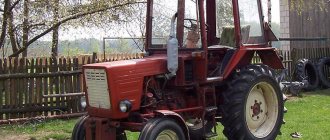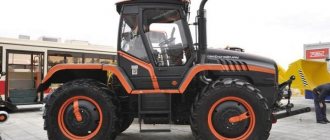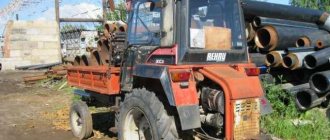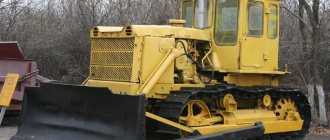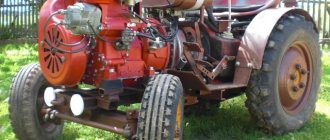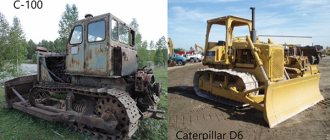By the 70s of the last century, it became obvious to progressive design engineers that the future lay in high-speed tractor units with increased power and the further evolution of tractor technology would go in this direction. Particular success in the development of this direction was made by the team of the Kharkov Tractor Plant named after Sergo Ordzhonikidze under the leadership of chief designer B.P. Kashuba.
In 1973, tractors of the T-150 type were accepted for mass production. A fundamentally new family of tractors was developed as a unified one, and the T-150 model existed in two modifications - tracked and wheeled. However, it was the wheeled model, the T-150K, that was especially popular. Its distinctive features: greater power, high productivity (2 times more compared to its predecessors), improved gearbox, and the ability to operate at high speeds (up to 15 km/h).
In total, the Kharkov Tractor Plant produced more than 753 thousand T-150K wheeled tractors and their modifications. The cars were successfully exported, raising the prestige of the country. In the USSR in the 70-80s of the last century, these powerful units became the first assistants in the countryside - they greatly improved working conditions and contributed to the rise of agriculture.
Predecessors
T-150K is not the first powerful wheeled tractor that was created at KhTZ.
Back in 1959, N. S. Khrushchev, after a trip to the USA, decided to “catch up and overtake” American farmers using wheeled tractors instead of tracked ones, and entrusted the development of a worthy competitor to the Kharkov tractor class=”aligncenter” width=”900″ height=”664 ″[/img] KhTZ Chief Engineer A. A. Soshnikov successfully completed this task. Under his leadership, a powerful wheeled tractor T-125 was created - a fundamentally new original model that has no analogues. It is believed that this tractor became the prototype of the T-150K. By the way, the T-125, like the T-150K, was a unified type vehicle, and it could be produced in a tracked version.
But still, we note that there was a fairly long gap between the release of the T-125 and T-150K models, during which the development of high-speed tracked tractors was carried out at the Kharkov plant. It was thanks to this experience that the T-150K was able to appear - the first powerful and high-speed wheeled tractor.
Subtleties of selection of tractor trailers.
The principle of forming a tractor-trailer set:
For example: a regular composition of a K-701 Tractor (total weight 15 tons) and a 1PTS-9 hitch (total weight 14 tons) with a 3PTS-12 (total weight 18 tons), that is, the total weight of the hitch is 32 tons. , but here is a composition of the K-701 Tractor (total weight 15 tons) and the OZTP-8573 hitch (total weight 21 tons) with the OZTP-8572 (total weight 19 tons), that is, the total weight of the hitch already reaches 40 tons .
Thus, the total weight of the hitch used on all types of roads can be twice the tractor’s own weight, subject to the mandatory use of the trailer braking system. Moreover, the total weight of the hitch used on Group I roads can be two and a half to three times the tractor’s own weight. Another option is possible - when transporting Class III and IV cargo, the total weight of such a hitch is also reduced, which allows them to be used on all types of roads.
For example: a conventional composition of the MTZ-82 Tractor (total weight 4 tons) and the 2PTS-6 trailer (total weight 9 tons) used on all types of roads is twice the tractor’s own weight and is the “limit” when transporting cargo II and I Class. However, when transporting Class III and IV cargo, the coupling of two 2PTS-4 (curb weight 1800 kg) does not exceed the total coupling weight of 9 tons and allows the use of all types of roads. Moreover, when transporting Class III and IV cargo, the PPTS-5 (curb weight 1830 kg) and 2PTS-4 (curb weight 1800 kg) coupling can be used, which does not exceed the total hitch weight of 10 tons and allows the use of all types roads, since the PPTS-5 semi-trailer adds additional load to the rear axle of the tractor and increases its traction capabilities.
Power plus speed...
The development of high-speed tractors was undertaken by the chief designer of KhTZ B.P. Kashuba. In particular, he created an experimental series of high-speed tracked tractors DT-54M. Together with the All-Russian Research Institute of Agricultural Mechanization, laboratory and field studies were carried out at high speeds (5-9 km/h). The tests were successful, proving that the path of modernizing tractors towards speed is quite promising.
HTZ began producing a series of high-speed tractors almost like hot cakes! 1960 - the first high-speed tracked tractor T-75 in the USSR, 1962 - T-74. The operation of these machines has shown that it is possible to further increase operating speeds and it is quite possible to create even faster models.
Device. Cabin and comfort
| T 150 what engine - Special equipment The modified T-156 machine is equipped with a bucket and is capable of performing loading work, and the LT-157 is a skidder and is used in logging. 150 165 Volume of built-in fuel tank, l 315 375 Total weight of equipment, tons 6.97 7.6 Length, m 4.935 5.735 Width, m 1.85 2.4 Working track of equipment, m 1.435 1.68 Permissible ground clearance, not less , m 0.3 0.4 Maximum speed, km h 32 30.8. |
| Features of using the T-150 tractor in agriculture According to expert estimates, the demand for modern Kharkov machines similar to the T 150 is limited by the high price, which is incomparable with the operational parameters and quality of the machines. All modifications of tractors are equipped with diesel six-cylinder four-stroke supercharged SMD-60 engines with a 150-horsepower rated power. |
- reduced pressure on the soil (this is largely due to the wide tracks), which means a reduction in the harmful impact on the ground by about half;
- reduced slipping by three times and a high percentage of cross-country ability;
- reduction in fuel consumption by 10% compared to the wheeled version;
- significant increase in equipment productivity;
- improving labor safety;
- low fuel consumption and ease of operation of the tractor.
...plus wheels!
Finally, in 1967, Kashuba turned to the chief engineer of KhTZ V.V. A book with a proposal to develop at the plant a fundamentally new model of a powerful high-speed caterpillar tractor. However, the chief engineer set his own condition: that the new tractor be unified - have the possibility of both tracked and wheeled modifications.
This was a real challenge, because creating a unified unit is much more difficult than creating a tracked or wheeled unit separately. Nevertheless, the plant, the team and the chief designer coped with this task! As a result, tractors like the T-150 were born. In 1973, the State Commission approved their serial production, and in 1974 a Resolution was adopted on the creation of capacities for their production.
The wheeled model has gained great popularity. The wheels made it possible to use the tractor not only in the fields, but also for road work: the T-150K is adapted for movement on highways.
Dimensions T-150
| Length | 4 325 mm |
| Width | 1 850 mm |
| Height | 2,895 mm |
| Base | 1 800 mm |
| Track | 1,435 mm |
| Road (agrotechnical) clearance | 300 mm |
Tractor engine T-150K
Engine SMD-62, six-cylinder, four-stroke, turbocharged, diesel, 165 hp. (121.5 kW), with a crankshaft speed of 2100 rpm, was specially developed for the T-150K model. The engine cylinders are arranged in a V-shape with a camber angle of 90°. The cylinder bank houses the turbocharger and exhaust manifolds. Air is supplied to the cylinders by a turbocharger under excess pressure. Turbocharging increases the flow of air into the cylinders, which allows for increased power without increasing specific fuel consumption.
The fuel is injected by an injector into the combustion chamber, an open, toroidal, undivided type, located in the thick-walled piston crown. The toroidality of the piston ensures maximum air swirl. Direct injection of fuel into the combustion chamber (piston recess) makes it easier to start the engine and reduces specific fuel consumption.
The engine runs on diesel fuel. At air temperatures above 0 °C, use summer fuel, grades L or DL, at temperatures from 0 to -30 °C - winter fuel, grades 3 or DZ, at temperatures below -30 °C - arctic fuel, grades A or DA.
On the T-150K tractor, a two-stroke carburetor with crank-chamber purge starting engine P-350 with a power of 10 kW is installed on the flange of the diesel engine flywheel housing. The intake of the combustible mixture and the exhaust of exhaust gases is carried out through windows located in the engine cylinder, which are opened and closed by a piston.
Specifications
The powerful and maneuverable wheeled all-wheel drive tractor has very compact dimensions of 6.13 x 2.46 x 3.17 meters. The dry weight of the machine is 8400 kg, the wheelbase is 2.86 meters, the track is -1.68/1.86 m. The road clearance of the tracked and wheeled tractor is 300 and 400 mm, respectively, and the turning radius is within 6.5 meters.
The half-frame articulated frame is made of channels and beam crossbars, fastened with massive rivets. A power unit is installed in its front part, connected to the transmission through a clutch mechanism, a gearbox with a transfer gearbox and cardan drives. The articulated frame is rotated by the force of 2 hydraulic cylinders.
- Developer – Kharkov Tractor Plant
- Engine type – YaMZ-236D-3, diesel six-cylinder V-shaped
- Power – 165 horsepower
- Nominal revolutions per minute – 2100 rpm
- Engine displacement – 11 liters
- Electric starter – yes
- Fuel consumption – 220 g/kW per hour
- Transmission – mechanical with 12 forward speeds
- Independent power take-off shaft - yes
- PTO operating modes – 500 and 1000 rpm
- Brakes – with pneumatic drive
- Wheels – single or double (depending on modification)
- Rear linkage type – three-point hydraulic
- Lifting capacity – 4500 kgf
- Wheelbase volume – 2860 mm
- Track parameters – 1680 and 1860 mm
- Tractor dimensions, mm: Length – 6130, Width – 2406, Height – 3195
- Ground clearance – 400 mm
- Tractor weight – 8200 kg
- All-wheel drive 4x4 – yes
- Turning radius – 6500 mm
- Maximum forward speed – 30 km/h
- The maximum reverse speed is 10 km/h.
Engine
The T-150 was equipped with a six-cylinder diesel engine with 150 horsepower. On later versions, engine power was increased to 180 hp. Now, potential buyers are offered another modification of the T-150 tractor, with an engine from YaMZ with 175 horsepower.
The main engine is started using a gasoline PD-10.
The motor is cooled using air, which is first cleaned using cyclone oil filters. To facilitate starting in the cold season, the fuel is preheated using PZHB-10.
- Operating power 129 kW.
- The number of shaft revolutions per minute is 2100 times.
- Motor dimensions 112 x 105 x 106 cm.
- Own weight 1 ton 35 kg.
Fuel consumption
Fuel consumption in operating mode is 258 g/kWh. The fuel tank volume of the first models was 375 liters, in later versions this figure was increased to 430 liters.
Fuel combustion during operation reaches 28 liters in 1 working hour. A full tank of 430 liters is enough for a twelve-hour work shift of the unit and transportation to the garage.
Transmission
The operational capabilities of the T-150 are expanded due to a multi-range gearbox. The working, transport, slow and reverse modes each have four stages. The maximum transport speed of the T-150K version is up to 30 km/h.
The complexity of the gearbox design is compensated many times over:
- shifting down and up gears without interrupting power;
- flexible traction characteristics;
- multi-mode activation of working parts of mounted units.
Routine repair of the gearbox is possible without removing its housing from the transmission. The design of the power transmission provides the ability to disable the front axle.
Located in the center of the frame, the HTZ cabin of the 150th model has received a rigid internal frame since 1913, as well as more efficient heating. The list of standard equipment includes a comfortable steering column, a seat adjustable for operator weight and height, a fan, heated front glazing and rear hemisphere viewing mirrors.
The mechanical transmission of the T150 tractor has a number of features: When changing gears, there is no break in the power transition (during driving or operation); Adjustable traction characteristics; Support the required operating speed with the appropriate attachments. Torque from the gearbox is transmitted to the transfer case, and from there to the axles. At the transmission, power is taken off for special attachments, type KZK-10.
Hydraulic system
The T-150 tractor is equipped with a rear hitch of the third traction class, which is a hinged four-link three-point mechanism.
Thanks to the high engine power, this machine is designed for heavy work: plowing virgin lands with a large plow, clearing streets of snow, skidding forest, towing stuck cars and transporting loaded trailers.
Other Features
The engine, together with the clutch and gearbox, is mounted on the tractor frame on four supports equipped with rubber-metal shock absorbers.
The T-150K has all driving wheels. The tractor is turned by the steering wheel using hydraulic cylinders acting on the articulated frame. Due to the “break” of the semi-frames in the horizontal plane, the tractor moves along a curved path.
The four-speed manual transmission, together with the clutch and engine, forms a common unit attached to the tractor frame on brackets and shock absorbers. The gearbox operates in several ranges (slow, working, transport and reverse), which are switched when the tractor stops. Gears are switched manually, without interrupting the power flow.
The T-150K has two brakes: central and wheel. The central handbrake is used for stopping in a parking lot. Wheeled is used to reduce the speed or completely stop a moving tractor.
Gearbox Cab and Frame
| T 150k Fuel consumption per hour Tractor Dimensions and weight Tractor weight, kg 8150 2.5 Length without attachment with towbar, mm 5000 50 Width, mm 1880 30 Height, mm 2680 40 Base, mm 1800 Track, mm 1435 Ground clearance not less than mm 300 Engine Model YaMZ-236 Rated power, kW l. All modifications of tractors are equipped with diesel six-cylinder four-stroke supercharged SMD-60 engines with a 150-horsepower rated power. |
- hard (soil, compacted snow);
- gravel, sand (medium hard soil);
- wet (arable land, snow-covered virgin soil, off-road).
Design features and general technical parameters of the T-150k • The working parts of the new machines can operate at higher speeds with lower resistance than those of serial low-speed machines.
Cabin of the T-150K tractor
The cabin of the T-150K tractor is a special pride of the designers! Never before has it been so comfortable and convenient. The tractor driver in it could feel like a real king.
The spacious (for two seats) all-metal sound- and dust-insulated sealed cabin is equipped with a ventilation and heating system, equipped with a sun visor, a first aid kit, rear-view mirrors and glass cleaners. There are even hooks for clothes and a thermos for drinking water! The driver's seat is sprung and adjustable depending on the weight and height of the driver.
Factors affecting tractor fuel consumption
Excessive fuel consumption (or less than expected fuel consumption) can be caused by several factors. For example, one of the main reasons is the technical condition of the tractor power unit. Experts advise checking the internal combustion engine for problems before starting work.
Photo source: exkavator.ru/trade Fuel consumption is determined by a number of different factors
The indicator is also affected by the operator's driving style (aggressive driving, incorrect speed or incorrect gear shift mode). Weather conditions, seasonality of work and landscape are also reasons for the increase or decrease in tractor fuel consumption.
The level of fuel consumption per hour when driving depends on the load capacity of the trailer, as well as on the type of road surface. Manufacturers distinguish three types of roads depending on their condition:
- Paved roads; field roads; packed snow roads.
- Roads with gravel, crushed stone (broken) or sandy (country) surfaces; unpaved roads after rain; turfed soil with hard surface; stubble of grain crops.
- Deep rutted roads; frozen or normal moisture arable land; ridge roads; thawed after a thaw; field after collecting root crops; virgin snow; off-road spring; broken roads.
Finding the necessary equipment or spare parts has become even easier - leave a request and they will call you back.
World Star
The T-150K truly turned out to be a tractor of a fundamentally new class, not only in its powerful technical parameters, but also in design and level of comfort for the driver. Sealed comfortable cabins, a sprung tractor driver's seat, light and comfortable steering, transmissions with gear shifting on the fly, stable heavy-duty tires - all this was noted not only by domestic but also foreign experts, and the T-150K successfully entered the world market.
From 1973 to 1977, the tractor received five gold awards at international exhibitions! In 1979, during tests in the USA (International Tractor Test Site, Nebraska), the T-150K developed a thrust that was almost equal to its weight, and the Americans immediately dubbed it a tractor that can lift itself.
In 1980, the creator of the revolutionary unit, the Kharkov Tractor Plant, received the international Golden Mercury award for peace and cooperation. Thanks to the worldwide recognition of the T-150K, KhTZ has significantly increased its exports. From 1976 to 1990, 21,863 such models were delivered to the USA, Canada, Australia, Europe, Asia and Africa.
Modifications
There are three main types of this tractor. The T-150KS1 is equipped with a hydraulic attachment system, an independent power take-off shaft, a trailing shackle and a harness, a PZHB-300 preheater, a hydraulic hook, an evaporative air cooler and a breakaway coupling with hoses.
The T-150KS2 is equipped in the same way as the T-150KS1, but without the rear linkage, power cylinder with hoses, PTO, hydraulic hook and pre-heater.
T-150KSZ is a tractor with a hydraulic traction hook. It is equipped in the same way as the T-150KS1, but without a towing bracket and harness, PTO and pre-heater (a breakaway coupling with hoses is included with the tractor).
Numerous modifications were created on the basis of the T-150 family of tractors: the T-156 loader, the T-150D and T-150DK bulldozers, the T-155 military engineering tractor, the T-158 and T-157 industrial and forestry tractors, the ESVM-7 chemical treatment machine and etc.
Subscribe to our Telegram channel
Coupling with trailers and semi-trailers
For the transportation of bulk and bulk agricultural cargo on good roads, the T-150K tractor is aggregated with a transport train consisting of a 1PTS-9 semi-trailer and a ZPTS-12 trailer. In unfavorable road conditions, the tractor is coupled only with the 1PTS-9 semi-trailer.
To work with semi-trailers, the T-150K tractor is equipped with a hydraulic hook. Two-axle trailers can be aggregated with a tractor equipped with a trailing and harness bracket.
The procedure for connecting the tractor to the trailer:
- Remove people from the trailer and sound a warning signal.
- Remove the lower pin securing the hook latch.
- Turn on the pump of the hydraulic system of the attachment and start the SMD engine.
- Lower the hydraulic hook to the lower position and place the distributor lever in the “Lower” position.
- Slowly back up to the trailer so that the hook is under the towing eye. Raise the hook by inserting it into the loop.
- Secure the hook latch with a spring pin.
- Using the distributor lever, set the hook to the transport position (corresponding to the lifting of the drawbar of the trailer for agricultural implements), and then move the distributor lever to the neutral position.
- Connect the hydraulic and pneumatic systems of the trailer with the corresponding systems of the tractor.
- Connect the plug connector of the trailer alarm circuits to the tractor socket.
- Connect the tractor to the trailer with safety chains or cables.
- When using the hydraulic hook, the distributor lever must be in the Neutral position and the attachment hydraulic pump must be off. The static vertical load on the hook should not exceed 2000 kgf.
The procedure for disconnecting the T-150K tractor from a semi-trailer:
- Lower the semi-trailer drawbar support and disconnect the safety chains or cables connecting the semi-trailer to the tractor.
- Disconnect the hydraulic and pneumatic systems of the semi-trailer from the tractor and unplug the trailer alarm circuit plug.
- Remove the lower finger, press the hook latch and lock it with your finger in the open position of the hook.
- Remove the hook from the loop of the semi-trailer, setting the distributor lever to the “Lowering” position, and drive away from the trailer, first sounding the sound signal.
- Place the hook in transport position.
Every shift it is necessary to clean the parts of the hydraulic hook from dirt and check the reliability of fastening of the safety chains, the locking of the hook latch, and the cotter pins of all fastening pins.
The pressure in the tires of the front wheels of a tractor coupled with semi-trailers is set at 1.4 ± ±0.1 kgf/cm2, in the tires of the rear wheels—1.8 ± 0.1 kgf/cm2.
When working with trailers that do not create a vertical load at the trailer point, the pressure in the tires of the front wheels of the tractor should be 1.6 + 0.1 kgf/cm2, in the tires of the rear wheels - 1.2 ± 0.1 kgf/cm2.
When assembling the T-150K wheeled tractor with agricultural machines driven by a PTO, the left and right braces should be secured to the rigid braces of the hydraulic hook in the following order:
- disconnect the brace earrings from the trailer beam and braces;
- by acting on the distributor lever, lower the attachment below its original position;
- place the fork of the braces behind the braces and secure them with your fingers along with the brace earrings;
- Working on the distributor lever, carefully lift the attachment to the upper position of the brace fork on the extension.
When performing transport work, the front axle of the tractor must be turned off. Failure to comply with this requirement will result in rapid tire wear.
Engaging the front axle during transport work is allowed only for a short time to overcome obstacles and in case of increased slipping on dirty roads and icy conditions.
When performing transport work, the tractor wheels must be installed only on a wide track.
For transport work, the tractor may only be coupled with trailers and semi-trailers that have a working braking system.
, the T-150 crawler tractor is combined with a trailed two-axle dump trailer 2PTS-6 with a lifting capacity of 6 tons.

